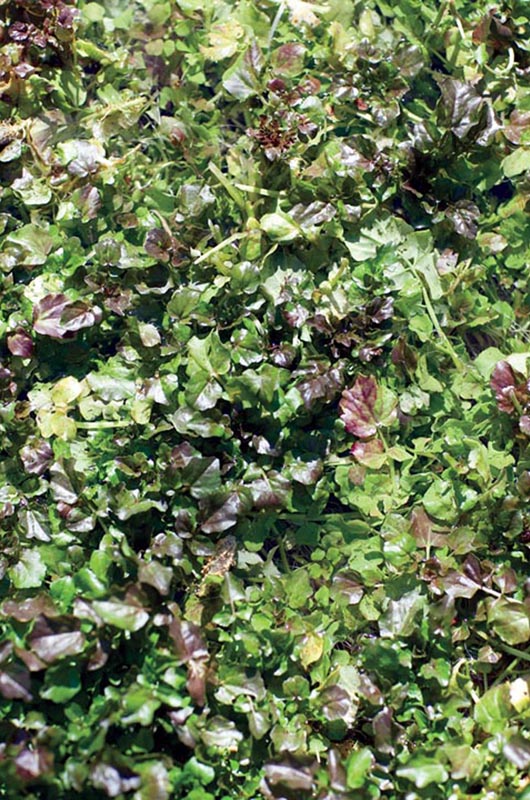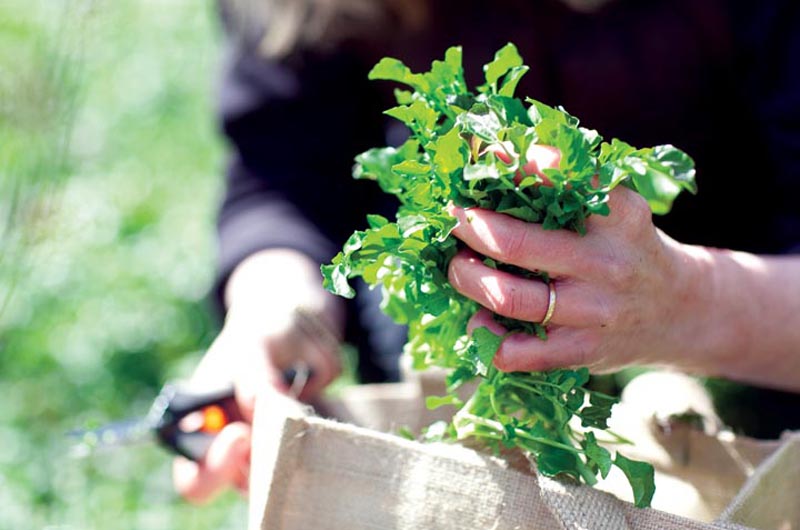This time of year, it is not unusual to find an abundance of watercress in and around the woods. Watercress is available in many places on the Vineyard where there are streams of shallow moving water.
Watercress (Nasturtium officinale) is an aquatic leafy green vegetable that tastes peppery like a Nasturtium leaf or flower. It is stupendously good for you and this time of year, when we have only been seeing kale and more kale, it is a welcome addition to our daily greens. It seems like just what our bodies are calling for, nutrient-wise.
Watercress is the latest in a long line of so-called “superfoods” that have been found to have beneficial and protective health benefits. This green powerhouse contains 15 essential vitamins and minerals. It has more vitamin C than oranges, more calcium than milk, and even more iron than spinach. Watercress also contains beta-carotene (vitamin A equivalents), iodine, copper, potassium, and is also a great source of antioxidants.
As watercress is a cruciferous green, it is rich in anti-cancerous phytochemicals such as beta-carotene and flavonoids. It’s also high in iodine, important for those concerned with hyperthyroidism or their thyroid in general.
The British Journal of Nutrition and Biochemical Pharmacology published two studies in 2010 that show possible insight into the potential anti-cancer benefits of watercress. Watercress contains a compound, the same compound that gives it a peppery taste, which acts as a shield and helps prevent the cancer cells from stealing oxygen and growing. The micronutrients of watercress work with the antioxidants to combat cancer-friendly free radicals in the body.
The raw leaves offer the highest nutrient value and watercress can be juiced with just about anything for a perfect green smoothie. I like to add one chopped apple, a handful of organic grapes, one cup of chopped pineapple, two cups of watercress, one cup of coconut and blend. This meets three of my six servings of fruit and vegetables for the day.
When you go out foraging, bring a plastic bag and a pair of scissors. Be sure to leave behind the roots and cut the top. The watercress will also grow back a lot easier if you don’t pull out the roots, which tend to come out when you pick it by hand. We like to harvest from different areas, not just the same hedge, but all down the creek bed. I have often been tempted to grab a bunch by their roots and transplant watercress to the Tiasquam River that runs near my house. When I mentioned this to my son and his girl friend who are students of environmental science, they laughed at me. My son said: “Why don’t you get some other invasive species like crocodiles and introduce those to the Tiasquam River!” I wonder how much damage watercress brings to the waterways?
If you are not a forager, there is some beautiful red watercress available in stores that comes from Fellsmere, Fla., reportedly the world’s largest watercress grower. The wild red watercress was discovered in a semitropical wetland at the northern headwaters for the Florida Everglades. The grower reports that they grow their watercress sustainably.
I love a watercress salad. In the 1980s there was a restaurant called the Ocean Club located at Five Corners. The restaurant served a watercress salad that included olive oil, lemon juice and shaved Parmesan cheese. This continues to be my favorite way to serve watercress. Sometimes I love to chop it very fine for a slaw, and other times I leave it big and long and wild on the plate. When I need a more substantial salad, I add my favorite lentils.
Watercress Lentil Salad
6 medium parsnips
2 tbsp olive oil
1 cup Puy lentils
1 bay leaf
1/2 onion minced fine
small bunch of parsley stalks (optional)
1 large bunch of watercress, tough stalks removed
salt and black pepper
shaved parmesan, hard goat’s cheese or hard cheese
For the Dressing
1 clove garlic minced
1 tsp English mustard
2 tsp clear honey
3 Tbsp lemon juice
8 Tbsp extra virgin olive oil
Preheat the oven to 350 degrees F. Peel the parsnips and halve them lengthwise. To keep them all the same size, you may have to cut the tops in half lengthwise. Drizzle with olive oil and roast in the oven for 30 minutes, until tender and beginning to caramelize.
Meanwhile, put the lentils in a pan, add plenty of water, and bring to a boil*. Simmer for one minute, then drain. Return lentils to the pan and pour in just enough water to cover them. Add the bay leaf, onion and parsley stalks (if using). Bring to a very low simmer and cook slowly for about 30 minutes, until tender but not mushy.
In a separate bowl, whisk all the dressing ingredients together thoroughly with some salt and pepper.
Drain the lentils mixture. While still hot, toss the lentils with the dressing. Scatter the warm lentils, roasted parsnip chunks and watercress sprigs on serving plates and finish with a few cheese shavings on top.
*I add a piece of kombu to all my beans when cooking. The kelp has natural glutamates that enhance flavor, tenderizes the proteins, and adds invaluable vitamins, minerals, and trace minerals. I also add cumin, epazote, fennel, ginger or winter savory, which aid in bean digestion.
Watercress Soup
8 cups watercress, rinsed with the stalks
2 organic medium potatoes cut into small cubes
2 large onions chopped fine
4 pints vegetable stock
1 medium carrot diced small
3 stalks celery diced small
1/8 cup extra virgin olive oil
2 bay leaves
salt and white pepper to taste (I tend to put a generous amount of salt and pepper)
Note: Add watercress into the stock after reaching a boiling point to avoid depleting the nutrients by overheating.
Heat the oil in a pan and sauté the onions until sautéed through and just as they turn a golden color, add the carrots, celery, cubes of potatoes and bay leaf and stir to coat. Leave to cook for 10 minutes. Add the stock and stir well. Bring to a boil and cook for 10 minutes, or until potatoes are cooked through. Remove from heat. Add in the watercress, one cup at a time and stir in until just wilted, to preserve as much nutrition as possible. Pour into a blender — you may have to do it in batches. Blend well. Serve warm







Comments
Comment policy »